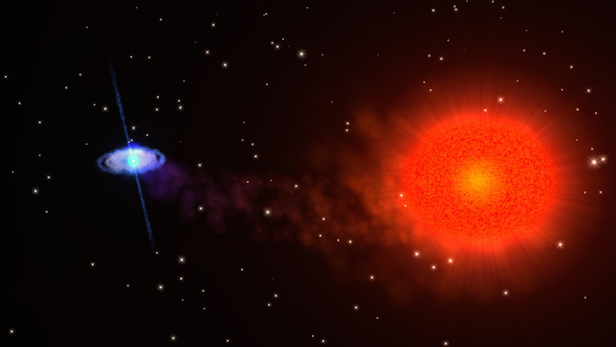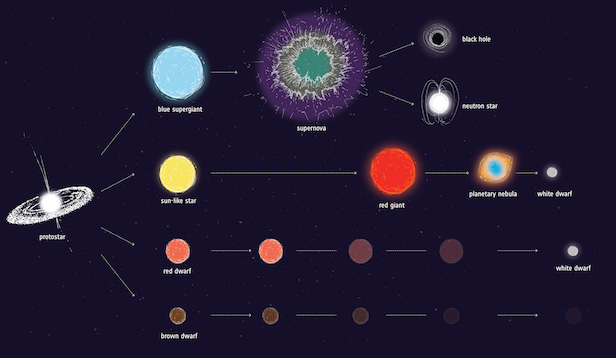Zombie star feeds off its companion
ESA’s Integral space observatory spotted X-rays emitted from a unusual binary star system

Stellar winds from the red giant star initiated the X-ray emission on the slow-spinning neutron star. Image credit: NASA
An unusual event was spotted by the European Space Agency’s (ESA) Integral space observatory recently. On 13 August 2017, a suddenly X-ray flare was spotted from an unknown source near the Milky Way’s core. After follow-up observation and analysis, it appears that the flare was from a slow-spinning neutron star triggered by a stellar wind from its red giant star companion.
After the initial detection in August 2017, astronomers tried to hunt down the hidden culprit for weeks. This hunt revealed a strongly magnetised and slowly spinning neutron star that had most likely digested material from its companion star, which is a massive red giant star.
Stars with masses similar to the Sun and up to eight times the mass of our Sun evolve into red giants towards the end of their lives. After they have ran out of hydrogen to burn in their core, the outer layers swell up and are slowly blown away by winds that travel a few hundred kilometres per second. As for larger stars, with masses up to 30 times the mass of our Sun, they exceed their fuel much faster than our Sun. After they have exceed their fuel, they will eventually explode in an event known as a supernova. Left behind is the remnant of its core with a strong magnetic field, which is dubbed a neutron star. A neutron star is incredibly dense, in fact a teaspoon of its material would weigh about 10 million tons, making it one of the densest objects in the universe.
Stars found in pairs are not a uncommon sight throughout the cosmos, however to find these two types together is very uncommon. Together, a neutron star and a red giant is known as a ‘symbiotic X-ray binary’ system, and there are no more than 10 of these known.
“Integral caught a unique moment in the birth of a rare binary system,” says Enrico Bozzo from the University of Geneva, Switzerland. “The red giant released a sufficiently dense slow wind to feed its neutron star companion, giving rise to high-energy emission from the dead stellar core for the first time.”

The evolution of a star is dependant on its mass, and the more mass means the quicker the evolution occurs. Image credit: ESA
Further observations made by ESA’s XMM-Newton and NASA’s NuSTAR space telescopes revealed more irregularities with the binary star system. It appears the neutron star only completes one spin every two hours, which is incredibly slow when compared it to other neutron stars that commonly spin many times per second. Then the first measurements of its magnetic field showed it has a surprisingly strong magnetic field. A strong magnetic field is normally an indication of a young neutron star, declining gradually with time. As the red giant star is much older, it seems odd that these two stars have grown up together.
“These objects are puzzling,” says Enrico. “It might be that either the neutron star magnetic field does not decay substantially with time after all, or the neutron star actually formed later in the history of the binary system. That would mean it collapsed from a white dwarf into a neutron star as a result of feeding off the red giant over a long time, rather than becoming a neutron star as a result of a more traditional supernova explosion of a short-lived massive star.”
As the red giant continues to reach the end of its life, its swollen outer shells will continue to cast winds into the cosmos. This wind will rain material down on the young neutron star, slowing its spin and initiating X-ray flares.
“We haven’t seen this object before in the past 15 years of our observations with Integral, so we believe we saw the X-rays turning on for the first time,” says Erik Kuulkers, ESA’s Integral project scientist. “We’ll continue to watch how it behaves in case it is just a long ‘burp’ of winds, but so far we haven’t seen any significant changes.”
Keep up to date with the latest reviews in All About Space – available every month for just £4.99. Alternatively you can subscribe here for a fraction of the price!




